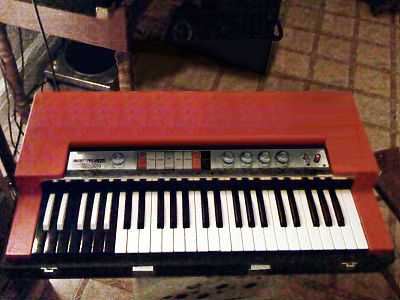Combo organ
A combo organ, so-named and classified by popular culture due to its original intended use by small, touring jazz, pop and dance groups called combo bands...as well as some models having "Combo" as part of their brand or model names, is an electronic organ of the frequency divider type, generally produced between the early 1960s and the late 1970s. This type of organ predated, and contributed largely to, the development of modern synthesizers. The combo organ concept, at least in the context of mass-production, is thought to have arisen from popular demand, when smaller home organs were seen in music stores. Combo organs were probably originally developed in Italy, and some included the inner workings of transistor accordions. They were the brainchild of necessity for portable organs of simple design, mainly for use in these small groups. Combo organs ended up having a major impact on the music scene of the mid- and late 1960s, particularly on rock and roll of that era.
Details

The definition of a combo organ is an electronic portable organ, usually transistorized (although some early designs used tubes while from the late 1960s onwards many models incorporated integrated circuits), and were designed for use on stage, usually in the context of a band or group. Combo organs were best known for their bright, reedy, (or what some would describe as "cheesy") sound; their portability; surprising versatility; and relatively low price tag. Most such instruments have no built-in amplification - a guitar-type amplifier would normally be used. A typical combo organ has one keyboard, covering four or five octaves, though a few models had two keyboards of three or four octaves. Such instruments were often called a "Combo Duo." A number of different pitches and tone-colours can be selected, usually via rocker switches known as stop-tabs or sliders called drawbars. Although the sounds may bear such names as "flute", "string" or "horn", they are not intended to sound like their orchestral namesakes - the nomenclature is borrowed from pipe organ tradition. Some instruments allow the keyboard to be split, the lowest octave or two producing a pedal-like bass tone. Most combo organs allow vibrato to be added to the sound; a few feature more unusual effects such as "repeat percussion" (tremolo), "slalom" (pitch bend) or wah-wah. A volume pedal is normally used to vary the volume while playing. Less frequently an optional set of bass pedals can be attached. A combo organ is usually supported on a removable or folding stand or legs; these originally would have been supplied as part of the instrument. Soundwise, combo organs are very similar to each other, although there are definite discernible tonal characteristics that differ between models that might be considered "default" for each model. For instance, the Vox Continental tends toward having somewhat of a Hammond-like, or "sine wave"-like sound (only thinner); while the Farfisa Combo Compact has a wiry, aggressive, muscular bite to some of its boosted tones, and the Gibson G-101 has a cleaner, contoured, more "sawtooth wave"-like tone, with harpsichord-like, percussive sound capabilities and a slight "after-jingle", with Sustain selected, on some voice settings. To current collectors, players and enthusiasts, the visual aesthetic is often as important as the sound; the instruments were often available in bright and unusual colors (orange, blue, bright red, green) with showy chrome legs, multi-colored stop-tabs and reverse-colored or gray-and-white keys. Towards the mid-1970s, combo organs began to take on a more muted appearance, with woodgrain or black covering and conventional keyboard colors.
Many combo organs were produced in such countries as Italy or Japan, yet some more common models used by major acts were manufactured in the United Kingdom or the USA.
Organs intended to emulate the sound and characteristics of a Hammond organ are not generally regarded as combo organs; see clonewheel organ.
Models
_live_at_NBI.jpg) Farfisa Combo Compact  Ace Tone TOP-1 |
 Yamaha YC-30  Doric 61TT |
Well-known combo organs include:
- Vox Continental
- Vox Jaguar
- Farfisa Combo Compact series
- Farfisa Professional, VIP and FAST series
- Yamaha A3 and YC series
- Doric Organ
- Ace Tone "TOP" series
- Gibson G-101
- Fender Contempo
Popularity
The combo organ's greatest popularity was during the 1960s, when it was featured on hits by The Doors, The Animals, Iron Butterfly, Manfred Mann, Them, Strawberry Alarm Clock, and many others. Although the instrument fell from favor during the 1970s there was a resurgence about 1977 when new wave artists such as Blondie, Elvis Costello, Talking Heads and XTC started using them. More recently, vintage combo organs have been enjoying a substantial comeback, particularly among collectors, aficionados and players known affectionately as "Combo-nauts," and have been used extensively by The Horrors, Stereolab, Pulp, Kaiser Chiefs and Arctic Monkeys. Apparently, as of 2009, combo organs have been the most sought-after items in the vintage keyboard market, with numerous young keyboardists performing demos on YouTube and other websites.
External links
- Combo Organ Heaven Extensive site about numerous combo organ manufacturers and models
- Combo Organ Nation Forum for combo organ owners